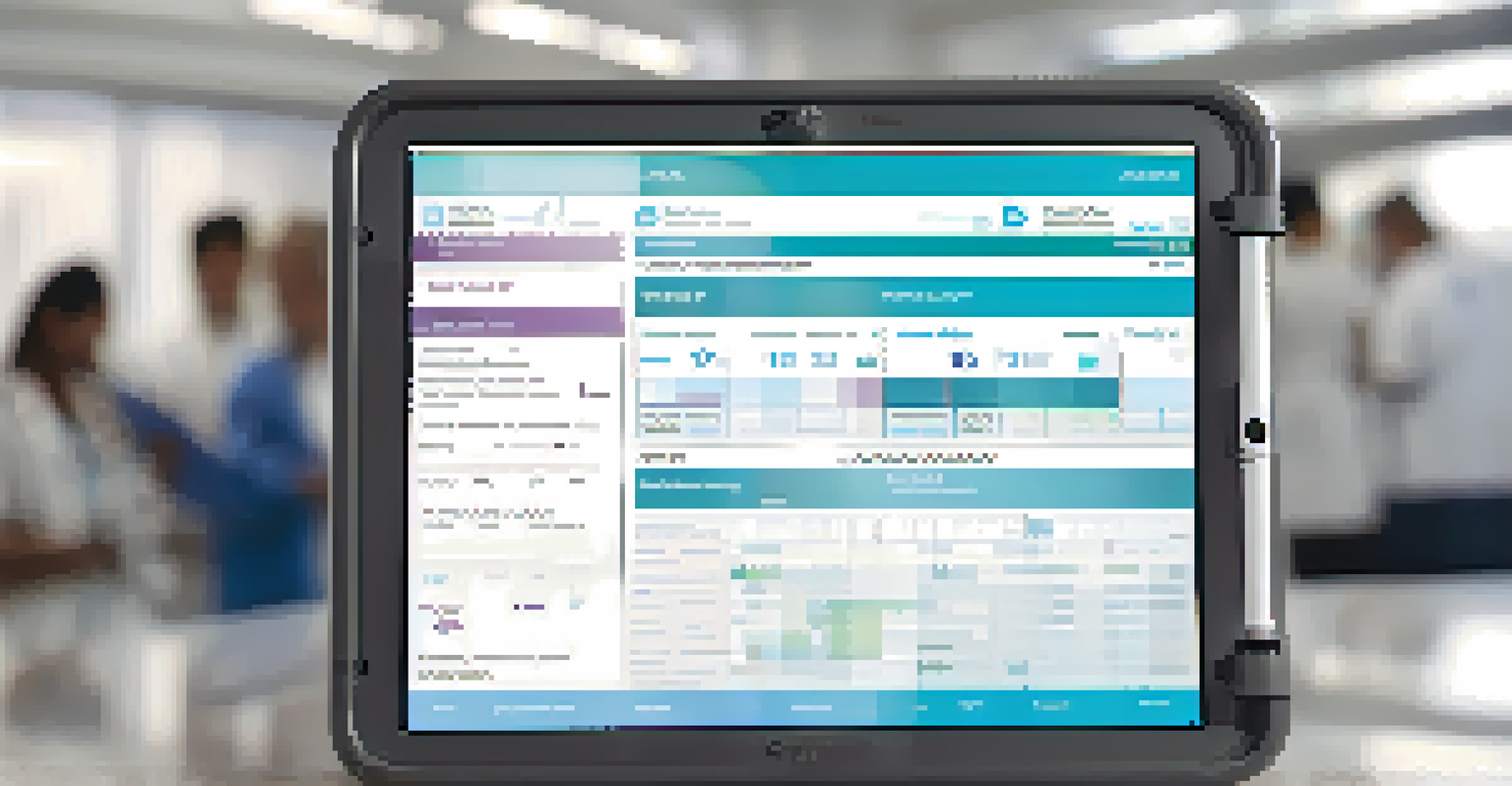Real-World Examples of EHR Success Stories

Streamlining Patient Care at ABC Hospital
At ABC Hospital, the implementation of an Electronic Health Record (EHR) system drastically improved patient care. By centralizing patient information, healthcare providers can access comprehensive medical histories in real-time, reducing the chances of errors during treatment. For example, a nurse can quickly check for allergies before administering medication, enhancing patient safety.
The secret of change is to focus all of your energy not on fighting the old, but on building the new.
Moreover, the EHR system allows for better coordination among different departments. With shared access to patient records, specialists and primary care doctors can collaborate more effectively, leading to more informed decision-making. This seamless communication ultimately results in a smoother patient experience.
Since adopting the EHR, ABC Hospital has reported a notable decrease in patient readmission rates. By leveraging data analytics, the hospital can now identify at-risk patients and intervene earlier, significantly improving health outcomes. It’s a classic case of technology enhancing the human touch in healthcare.
Reducing Administrative Burden at XYZ Clinic
XYZ Clinic faced overwhelming administrative tasks that burdened its healthcare staff. By transitioning to an EHR system, they automated many processes, such as appointment scheduling and billing. This change not only saved time but also allowed staff to focus more on patient care rather than paperwork.

The clinic also implemented a patient portal, giving patients easy access to their medical records and lab results. This transparency fosters a sense of empowerment among patients, encouraging them to take an active role in their health. In turn, this has led to higher patient satisfaction scores.
EHR Enhances Patient Safety
The implementation of Electronic Health Records (EHR) improves patient safety by centralizing medical histories and reducing treatment errors.
As a result of these improvements, XYZ Clinic has seen an increase in patient volume. With less time spent on administrative tasks, the clinic can accommodate more patients while maintaining high-quality care. This strategic move demonstrates how EHR systems can enhance operational efficiency in healthcare.
Enhancing Data Security at DEF Health Center
In an era where data breaches are a significant concern, DEF Health Center prioritized patient data security with its EHR implementation. They adopted robust encryption methods and regular security audits, ensuring that sensitive patient information remains protected. This proactive approach has instilled trust among patients, knowing their data is secure.
Technology is best when it brings people together.
The EHR system also provides an audit trail, allowing the health center to track who accessed patient information and when. This feature helps in identifying unauthorized access attempts and enhances accountability among staff. Such transparency is crucial in maintaining patient trust and adhering to regulatory requirements.
Thanks to these security measures, DEF Health Center has had zero reported data breaches since implementing their EHR system. This success story highlights the importance of integrating security features in EHR systems, showcasing how technology can safeguard patient information while improving healthcare delivery.
Improving Patient Engagement at GHI Health System
GHI Health System recognized the need to boost patient engagement and adopted an EHR system that included interactive features. Patients can now schedule appointments, access educational resources, and communicate with their healthcare providers through a user-friendly interface. This accessibility encourages patients to take charge of their health.
The EHR also tracks patient progress and sends reminders for preventive screenings and vaccinations. These automated reminders have led to an increase in patient compliance with recommended health checks, which is essential for early detection of health issues. Engaged patients are more likely to participate in their care journey.
EHR Boosts Patient Engagement
Interactive features in EHR systems empower patients to take an active role in their health, leading to higher satisfaction and compliance.
As a result, GHI Health System has seen improved health outcomes across various patient demographics. By focusing on engagement, they have not only enhanced the patient experience but also strengthened the overall community’s health. This success story illustrates how EHR can play a pivotal role in fostering a proactive healthcare culture.
Boosting Telehealth Capabilities at JKL Medical Group
With the rise of telehealth, JKL Medical Group utilized their EHR system to enhance virtual care capabilities. By integrating telehealth solutions directly into their EHR, healthcare providers can offer remote consultations seamlessly. This has been particularly beneficial during times when in-person visits are limited.
The EHR allows for real-time sharing of patient data during telehealth sessions, ensuring that providers have all the necessary information at their fingertips. For instance, doctors can access lab results and medication histories while discussing health concerns with patients online. This continuity of care is essential for effective treatment.
Since implementing these capabilities, JKL Medical Group has experienced a significant increase in patient engagement with telehealth services. Patients appreciate the convenience of accessing care from home, leading to improved satisfaction rates. This success story reflects the growing importance of integrating EHR systems with modern healthcare delivery methods.
Facilitating Research and Innovation at MNO Hospital
MNO Hospital has leveraged its EHR system to facilitate medical research and innovation. By aggregating anonymized patient data, researchers can identify trends and insights that drive clinical studies forward. This data-driven approach has led to groundbreaking discoveries in patient care and treatment options.
The hospital collaborates with universities and research institutions, allowing for shared access to EHR data. This partnership not only enhances research capabilities but also fosters a culture of continuous learning among healthcare professionals. It’s a win-win, as both patient care and research quality improve.
EHR Supports Research and Innovation
Aggregating patient data through EHR systems facilitates medical research, driving advancements in treatment and patient care.
Since integrating research with their EHR system, MNO Hospital has contributed to several published studies and improved treatment protocols. This success story showcases how EHR can bridge the gap between healthcare delivery and scientific advancement, ultimately benefiting patients.
Scaling Operations at PQR Health Network
PQR Health Network faced challenges in scaling its operations across multiple locations. By implementing a unified EHR system, they ensured that all facilities operated on the same platform. This standardization streamlined processes and allowed for consistent patient care across the network.
The EHR system enables data sharing across locations, meaning that a patient’s medical history is accessible regardless of where they receive care. This holistic view of patient information fosters better communication among providers and enhances treatment continuity. Patients feel reassured knowing their health data is always up to date.

As a result, PQR Health Network has successfully expanded its services without compromising quality. The EHR system has become a backbone for operational growth, illustrating how technology can support healthcare organizations in meeting increasing demands while maintaining high standards of care.
Empowering Providers with Decision Support Tools at STU Clinic
At STU Clinic, the integration of decision support tools within their EHR has empowered healthcare providers to make informed clinical decisions. These tools offer real-time alerts and reminders based on patient data, helping doctors adhere to clinical guidelines. For instance, a prompt about a potential drug interaction can be a lifesaver.
The EHR’s analytics capabilities also allow providers to track patient outcomes and adjust treatment plans accordingly. By analyzing trends in patient data, healthcare professionals can identify what works best for their patients. This personalized approach enhances care quality and fosters trust between providers and patients.
Since the implementation of these decision support tools, STU Clinic has reported improved patient outcomes and reduced medication errors. This success story exemplifies the value of technology in empowering healthcare professionals to deliver safer, more effective care.